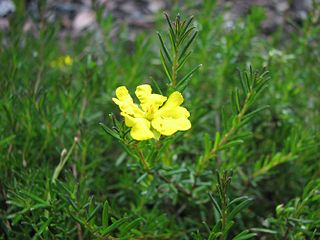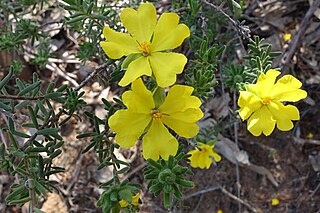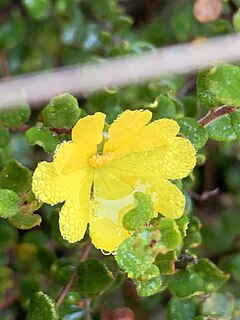
Hibbertia pedunculata, commonly known as stalked guinea-flower, is a species of flowering plant in the family Dilleniaceae and is endemic to New South Wales. It is a diffuse, prostrate or erect shrub with linear leaves and yellow flowers borne on a relatively long peduncle, the flowers with fifteen to twenty stamens arranged around two hairy carpels.

Hibbertia fasciculata is a species of flowering plant in the family Dilleniaceae and is endemic to south-eastern Australia. It is a small erect to spreading shrub with glabrous stems except on new growth, narrow linear leaves, and yellow flowers arranged in leaf axils, with eight to twelve stamens surrounding three carpels.
Hibbertia marginata, commonly known as bordered guinea flower, is a species of flowering plant in the family Dilleniaceae and is endemic to the North Coast of New South Wales. It is a spreading shrub with hairy young branches, oblong to lance-shaped leaves and yellow flowers with thirty to forty stamens and many staminodes arranged around three hairy carpels.

Hibbertia acicularis, commonly known as prickly guinea-flower, is a species of flowering plant in the family Dilleniaceae and is endemic to eastern Australia. It is an erect or prostrate shrub with linear to lance-shaped leaves and yellow flowers arranged singly in leaf axils with the six to eight stamens joined at the base, in a single cluster.
Hibbertia cactifolia is a species of flowering plant in the family Dilleniaceae and is endemic to the Arnhem Land escarpment. It is a multi-stemmed shrublet with hairy foliage, oblong to elliptic leaves and yellow flowers arranged singly in leaf axils, with twenty-six to twenty-eight stamens arranged in groups around the two carpels.

Hibbertia calycina, commonly known as the lesser guinea flower, is a species of flowering plant in the family Dilleniaceae, and is endemic to south-eastern Australia. It is a small shrub with linear leaves and yellow flowers with eight to eighteen stamens in a single cluster on one side of the two carpels.
Hibbertia circularis is a species of flowering plant in the family Dilleniaceae and is endemic to the northern part of the Northern Territory. It is a perennial herb with prostrate, trailing branches, elliptic to more or less round leaves, and yellow flowers arranged in leaf axils, with thirty stamens arranged in groups around the two carpels.
Hibbertia circumdans is a species of flowering plant in the family Dilleniaceae and is endemic to New South Wales. It is an erect shrub with hairy branches, linear to wedge-shaped or spatula-shaped leaves, and yellow flowers arranged on short side shoots, with fifteen to thirty stamens arranged in groups around the three carpels.
Hibbertia cistifolia is a species of flowering plant in the family Dilleniaceae and is endemic to northern Australia. It is a prostrate to low-lying sub-shrub with trailing, wiry stems, hairy foliage, oblong to elliptic leaves and yellow flowers arranged in leaf axils, with forty to fifty-eight stamens arranged around the two carpels.

Hibbertia covenyana is a species of flowering plant in the family Dilleniaceae and is endemic to New South Wales. It is an erect or semi-prostrate shrub with hairy foliage, oblong leaves and yellow flowers with seven to ten stamens arranged on one side of the two carpels.

Hibbertia decumbens is a species of flowering plant in the family Dilleniaceae and is endemic to a restricted area of New South Wales. It is a spreading, almost prostrate shrub with hairy foliage, egg-shaped to almost round leaves, and yellow flowers usually with nine to twelve stamens arranged in a group on one side of two carpels.
Hibbertia depilipes is a species of flowering plant in the family Dilleniaceae and is endemic to the far south-west of Western Australia. It is usually a sprawling shrub with scattered linear leaves and yellow flowers arranged singly in leaf axils usually with ten stamens all on one side of the two carpels.

Hibbertia dispar is a species of flowering plant in the family Dilleniaceae and is endemic to eastern Australia. It is a prostrate to low-lying shrublet with hairy, linear leaves and yellow flowers arranged on the ends of branchlets, usually with four to six stamens in a cluster on one side of two carpels.
Hibbertia fumana is a species of flowering plant in the family Dilleniaceae and is endemic to New South Wales. It is a low-lying to prostrate shrublet with narrow oblong leaves and yellow flowers with five to seven stamens arranged in a single cluster on one side of two hairy carpels. When first formally described in 2012 it was thought to be extinct, but small populations have since been found in the Sydney region.
Hibbertia haplostemona is a species of flowering plant in the family Dilleniaceae and is endemic to the Northern Territory. It is a small, short-lived sub-shrub with wiry, prostrate or low-lying stems, elliptic to egg-shaped leaves that are soon lost, and small red flowers with five stamens.

Hibbertia kaputarensis is a species of flowering plant in the family Dilleniaceae and is endemic to the Mount Kaputar area of New South Wales. It is a shrub with low-lying branches, oblong to lance-shaped leaves and yellow flowers with forty to about one hundred stamens arranged around three carpels.
Hibbertia pachyphylla is a species of flowering plant in the family Dilleniaceae and is endemic to Western Australia. It is a shrub with thick, oblong leaves and yellow flowers with five stamens in a bundle on one side of two hairy carpels.

Hibbertia patens is a species of flowering plant in the family Dilleniaceae and is endemic to south-eastern Queensland. It is a much-branched shrub with hairy foliage, linear to oblong leaves and yellow flowers arranged singly in leaf axils with 12 to 26 stamens arranged around two carpels.
Hibbertia persquamata is a species of flowering plant in the family Dilleniaceae and is endemic to the Northern Kimberley region of Western Australia. It is a spreading to prostrate shrub with flattened, scaly branches, narrow elliptic leaves and yellow flowers arranged singly in leaf axils with 20 to 26 stamens arranged around three scaly carpels.
Hibbertia pholidota is a species of flowering plant in the family Dilleniaceae and is endemic to a restricted area of Queensland. It is a spreading to scrambling shrub with scaly foliage, oblong leaves and yellow flowers with 30 to 36 stamens arranged around two densely scaly carpels.









